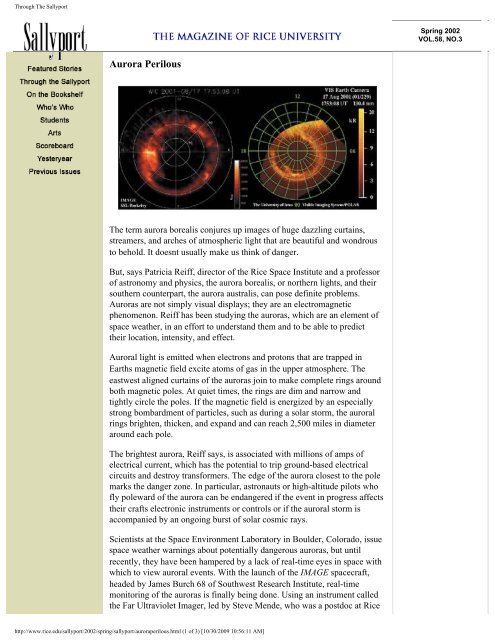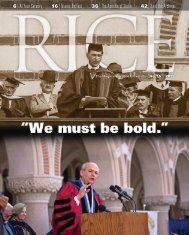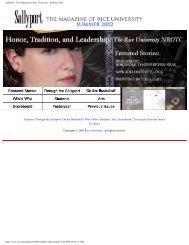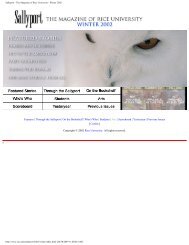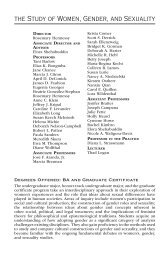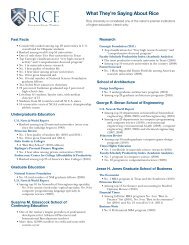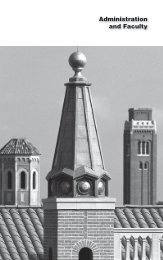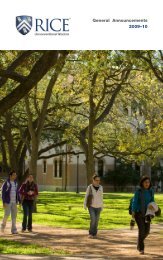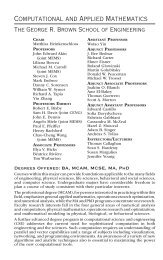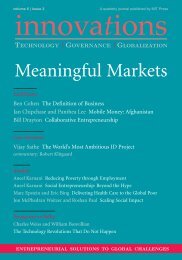Sallyport - The Magazine of Rice University - Spring 2002
Sallyport - The Magazine of Rice University - Spring 2002
Sallyport - The Magazine of Rice University - Spring 2002
You also want an ePaper? Increase the reach of your titles
YUMPU automatically turns print PDFs into web optimized ePapers that Google loves.
Through <strong>The</strong> <strong>Sallyport</strong><br />
<strong>Spring</strong> <strong>2002</strong><br />
VOL.58, NO.3<br />
Aurora Perilous<br />
<strong>The</strong> term aurora borealis conjures up images <strong>of</strong> huge dazzling curtains,<br />
streamers, and arches <strong>of</strong> atmospheric light that are beautiful and wondrous<br />
to behold. It doesn t usually make us think <strong>of</strong> danger.<br />
But, says Patricia Reiff, director <strong>of</strong> the <strong>Rice</strong> Space Institute and a pr<strong>of</strong>essor<br />
<strong>of</strong> astronomy and physics, the aurora borealis, or northern lights, and their<br />
southern counterpart, the aurora australis, can pose definite problems.<br />
Auroras are not simply visual displays; they are an electromagnetic<br />
phenomenon. Reiff has been studying the auroras, which are an element <strong>of</strong><br />
space weather, in an effort to understand them and to be able to predict<br />
their location, intensity, and effect.<br />
Auroral light is emitted when electrons and protons that are trapped in<br />
Earth s magnetic field excite atoms <strong>of</strong> gas in the upper atmosphere. <strong>The</strong><br />
east west aligned curtains <strong>of</strong> the auroras join to make complete rings around<br />
both magnetic poles. At quiet times, the rings are dim and narrow and<br />
tightly circle the poles. If the magnetic field is energized by an especially<br />
strong bombardment <strong>of</strong> particles, such as during a solar storm, the auroral<br />
rings brighten, thicken, and expand and can reach 2,500 miles in diameter<br />
around each pole.<br />
<strong>The</strong> brightest aurora, Reiff says, is associated with millions <strong>of</strong> amps <strong>of</strong><br />
electrical current, which has the potential to trip ground-based electrical<br />
circuits and destroy transformers. <strong>The</strong> edge <strong>of</strong> the aurora closest to the pole<br />
marks the danger zone. In particular, astronauts or high-altitude pilots who<br />
fly poleward <strong>of</strong> the aurora can be endangered if the event in progress affects<br />
their craft s electronic instruments or controls or if the auroral storm is<br />
accompanied by an ongoing burst <strong>of</strong> solar cosmic rays.<br />
Scientists at the Space Environment Laboratory in Boulder, Colorado, issue<br />
space weather warnings about potentially dangerous auroras, but until<br />
recently, they have been hampered by a lack <strong>of</strong> real-time eyes in space with<br />
which to view auroral events. With the launch <strong>of</strong> the IMAGE spacecraft,<br />
headed by James Burch 68 <strong>of</strong> Southwest Research Institute, real-time<br />
monitoring <strong>of</strong> the auroras is finally being done. Using an instrument called<br />
the Far Ultraviolet Imager, led by Steve Mende, who was a postdoc at <strong>Rice</strong><br />
http://www.rice.edu/sallyport/<strong>2002</strong>/spring/sallyport/auroraperilous.html (1 <strong>of</strong> 3) [10/30/2009 10:56:11 AM]


